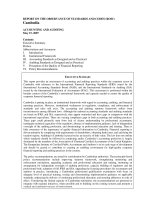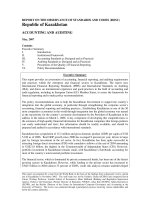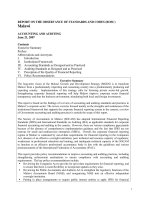On the Number of Partitions of Sets and Natural Numbers
Bạn đang xem bản rút gọn của tài liệu. Xem và tải ngay bản đầy đủ của tài liệu tại đây (111.29 KB, 12 trang )
Applied Mathematical Sciences, Vol. 3, 2009, no. 33, 1635 - 1646
On the Number of Partitions of Sets
and Natural Numbers
Hamzeh Torabi, J. Behboodian and S. M. Mirhosseini
Department of Statistics, Yazd University, Yazd, Iran
Abstract
In this article, we first state some relations about the number of
partitions of a set under some particular conditions and then we give
a new relation about the number of partitions of an n-set, i.e., Bell
number B(n). Finally, we give some formulas to count partitions of a
natural number n, i.e., partition function P (n).
Mathematics Subject Classification: 05A17, 11P82
Keywords: Bell number, partition number
1
Introduction
Partitions of sets and natural numbers have been a very attractive subject during the recent decades. Partitions play important roles in such diverse areas of
mathematics as combinatorics, Lie theory, representation theory, mathematical physics, and the theory of special functions. Because of some applications
of this subject, mathematicians have given some formulas in this regard. Up
to now, the number of partitioning of sets and natural numbers was considered
by some authors; for more details about partitions of sets and other related
subjects, see for example [8], [10], [15], [17], [18], [19], [20], [21], and [22], and
for partitions of natural numbers and other related concepts, see for example
[1], [2], [3], [4], [5], [9], [12], [13], and [14].
In this article, using some elementary tools of combinatorial analysis- see
[6], [7], [11], [16], and [23]- we give some alternative formulas for theses problems, considering also some special cases.
2
Partitions of sets
Definition 2.1 . A partition of a set A is any sequence of subsets A1 , ..., Am
1636
H. Torabi, J. Behboodian and S. M. Mirhosseini
of A, such that
m
i=1
Ai = A and Ai ∩ Aj = φ, ∀i = j.
The number of partitions of a set of size n ( n-set) is called the Bell number, in honor of famous mathematician “Eric Temple Bell” (1883-1960), and
denoted by B(n). By convention we agree that B(0)=1. Using Definition 2.1,
for n=1,2,3, we have B(1) = 1, B(2) = 2, B(3)=5 and so on.
In the following lemma, we state a relation for the number of partitions
of an n-set such that in every partition we have at least a subset with n − j
elements, j = 1, 2, ..., [ n2 ], n ≥ 2.
Lemma 2.1 .
Let B(n|n − j) be the number of partitions of a set with
n elements in which there exists at least a subset with n − j elements, j =
1, 2, ..., [ n2 ]. Then for n ≥ 2, we have
⎧
n
⎪
⎪
B(j),
j = 1, . . . , [ n2 ] − 1
⎨
j
B(n|n − j) =
n
⎪
⎪
j = [ n2 ]
(B([ n2 ]) − 12 δ([ n2 ], n2 )),
⎩
[ n2 ]
where
δ(x, y) =
1, x = y
0, x = y
Proof.
Let j ∈ {1, 2, ..., [ n2 ] − 1}. Because n − j > n2 , the statement
“at least a subset with n − j elements” is equivalent to “exactly a subset
with n − j elements”. n − j elements from n elements can be selected in
n
n
=
ways. But the remaining j elements can be partitioned
j
n−j
in B(j) ways. Hence
B(n|n − j) =
n
j
But,
n
n−[ ]=
2
Therefore, if n is odd, we have n −
B(j),
n
j = 1, 2, . . . , [ ] − 1.
2
n
,
if n is even
2
n+1
, if n is odd
2
[ n2 ] > n2 , hence
n
B(n|n − [ ]) =
2
n
[ n2 ]
n
B([ ]).
2
If n is even, we cannot partition the remaining
n
2
elements unconditionally,
n
because when the set is partitioned in two subsets with n2 elements, 12
[ n2 ]
1637
On the number of partitions of sets
partitions are counted twice and therefore in this case, we have
n
B(n|n − [ ]) =
2
n
1
B([ ]) −
2
2
n
[ n2 ]
n
[ n2 ]
.
✷
Example 2.1 . Find the number of partitions of a set with 5 elements in
which there exists exactly a subset with
(a) 4 elements;
(b) 3 elements.
Solution.
(a) we have B(5|4) =
5
1
B(1) = 5 × 1 = 5 :
{1, 2, 3, 4}, {5} {1, 2, 3, 5}, {4} {1, 2, 4, 5}, {3} {1, 3, 4, 5}, {2} {2, 3, 4, 5}, {1}
(b) we have B(5|3) =
{1, 2, 3}, {4, 5}
{1, 3, 4}, {2, 5}
{1, 2, 5}, {3, 4}
{2, 3, 5}, {1, 4}
{2, 4, 5}, {1, 3}
5
2
B(2) = 10 × 2 = 20 :
{1, 2, 3}, {4}, {5}
{1, 3, 4}, {2}, {5}
{1, 2, 5}, {3}, {4}
{2, 3, 5}, {1}, {4}
{2, 4, 5}, {1}, {3}
{1, 2, 4}, {3, 5}
{2, 3, 4}, {1, 5}
{1, 3, 5}, {2, 4}
{1, 4, 5}, {2, 3}
{3, 4, 5}, {1, 2}
{1, 2, 4}, {3}, {5}
{2, 3, 4}, {1}, {5}
{1, 3, 5}, {2}, {4}
{1, 4, 5}, {2}, {3}
{3, 4, 5}, {1}, {2}.
Example 2.2 . Find the number of partitions of a 4-set with at least a subset
with 2 elements( B(4|2)).
Solution.
Using Lemma2.1, we have
B(4|2) =
4
2
1
(B(2) − ) = 9.
2
These 9 partitions are as follows:
{1, 2}, {3, 4} {1, 3}, {2, 4} {1, 4}, {2, 3}
{1, 2}, {3}, {4} {1, 3}, {2}, {4} {1, 4}, {2}, {3}
{2, 3}, {1}, {4} {2, 4}, {1}, {3} {3, 4}, {1}, {2}.
Now, we state two other lemmas about the number of partitions of a set
with n elements in which all subsets have m elements. We indicate this number
by Pm (n).
1638
H. Torabi, J. Behboodian and S. M. Mirhosseini
Lemma 2.2 .
then
If m|n(i.e. there exist a natural number k such that n=km),
Pm (n) =
1
n
(m
)!
n
m, m, . . . , m
=
n!
n
n
(m
)!m!( m )
.
Proof. The number of ways that we can distribute n elements to
such that in every subset we have m elements, is
1
n
(m
)!
n
m, m, . . . , m
n
m
subsets,
.
Hence, by using definition of multinomial coefficients, this lemma is proved. ✷
Lemma 2.3 .
Let Pm (n) indicate the number of partitions of an n-set to
maximal number of subsets with m elements. We have
Pm (n) =
n
n
m[ m
]
n
(m[ m
])!
n 1
]).
n × B(n − m[
n
[m
]
m
[ m ]!m!
n
m[ m
] is the greatest multiple of m that is less than or equal to
n
n
n. These m[ m
] elements are selected in
ways. But the remaining
n
m[ m
]
n
]) elements must be partitioned arbitrarily. Thus, the relation is
(n − m[ m
proved.
✷
Proof.
Lemma 2.4 . Let m|n and Pm|n1 ,...nj (n) indicate the number of partitions of
an n-set into subsets of size m, such that in j subsets from m special elements of
n
the set, there exist in numbers n1 , n2 , ..., nj elements , j = 1, 2, ..., m
, ji=1 ni =
m. We have
1
m
Pm|n1 ,...,nj (n) =
×
j! n1 , n2 , . . . , nj
(n − jm)!
n−m
m − n1 , m − n2 , . . . , m − nj , n − jm
( n−jm
)!m!(
m
n−jm
)
m
.
Proof.
The number of ways in which m elements can be distributed to j
subsets, with numbers n1 , n2 , ..., nj is
1
j!
m
n1 , n2 , . . . , nj
.
But the number of elements of these j subsets isn’t still m. Therefore n − m of
the remaining elements must be partitioned to j + 1 subsets, in numbers m −
n − km + k−1
l=0 nl
,
n1 , ..., m−nj , and finally n−jm. This number is jk=1
m − nk
1
If m|n, then Pm (n) = Pm (n).
1639
On the number of partitions of sets
n−m
. Now the n − jm elements
m − n1 , m − n2 , . . . , m − nj , n − jm
are remained that must be partitioned. Using Lemma 2.2 and the product
axiom in combinatorial analysis, the relation is obtained.
✷
n0 = 0 or
Theorem 2.1 .
If m|n, then
n
m
Pm (n) =
j=1 {(n ,n ,...,n )| È
1
2
j
j
i=1
ni =m;ni ≥1,i=1,2,...,j}
n−m
m − n1 , m − n2 , . . . , m − nj , n − jm
1
j!
m
n1 , n2 , . . . , nj
(n − jm)!
( n−jm
)!m!(
m
n−jm
)
m
×
.
Proof.
Consider m special elements of the set {1, 2, ..., n}, for instance
n
1,2,...,m. These m elements can be distributed in m
arbitrary subsets. Consider a case that m elements in j subsets are distributed in numbers n1 , n2 , ..., nj ,
n
j = 1, 2, ..., m
, ji=1 ni = m. But the number of these cases is Pm|n1 ,n2 ,...,nj (n).
n
, the proof is
Now by using Lemma 2.4 and summing over j, j = 1, 2, ..., m
completed.
✷
Example 2.3 . Find the number of partitions of set {1, 2, ..., 9} in subsets
with 3 elements,
(a) without any condition;
(b) 3 elements 1, 2, 3 are in 3 different subsets.
Solution.
(a) Using Lemma 2.2, we have
P3 (9) =
9!
= 280.
3!3!3
(b) The number is P3|1,1,1 (9). Now, Using Lemma 2.4, we have
P3|1,1,1 (9) =
Theorem 2.2 .
1
3!
3
1, 1, 1
6
2, 2, 2, 0
0!
= 90.
0! 3!0
If n ≥ 1, then
n
B(n) =
j=1 {(n1 ,...,n j )|
Proof.
×
È
n
i=1
ni =n,ni ≥1,i=1,...,j}
By above lemmas, the proof is obvious.
1
j!
n
n1 , ..., nj
.
✷
1640
3
H. Torabi, J. Behboodian and S. M. Mirhosseini
Partition function
Definition 3.1 . A partition of a natural number n is any non-increasing
sequence of natural numbers whose sum is n.
In this section, we state some lemmas and theorems about P (n), the number of partitions of natural number n. By convention, we agree that P (0) = 1.
It can be shown that P (1) = 1, P (2) = 2, P (3) = 3, P (4) = 5 and so on.
Lemma 3.1 . Let P (n|1, 2, ..., m) be the number of partitions of a natural
number n, such that each summand is at most m. Then
P (n|1, 2, . . . , m) =
P (n);
m
j=1
m≥n
P (n − j|1, 2, . . . , j); m < n
Proof.
It is obvious that if m ≥ n, then condition “at most m” has
not any restriction. Therefore in this case, we have P (n|1, 2, ..., m) = P (n).
Now, let m < n. In this case the greatest summand is m. Because we can
arrange summands from left to right, non-increasingly, if in a partition we have
summand m, the remaining number (n − m), must be partitioned; but not
arbitrarily. This number must be partitioned such that the greatest summand
of this partition is m. These numbers are P (n − m|1, 2, ..., m). If we have
summand m − 1, the number n − (m − 1) must be partitioned such that any
summand is not greater than m−1. This number is P (n−(m−1)|1, 2, ..., m−1).
Continuing this method until the first summand in left partition is 1, and
summing on the number of all cases, the relation will be obtained.
✷
Theorem 3.1 . We have
⎧
⎪ 1, n
⎨
[2]
P (i),
P (n) =
i=0
⎪
⎩ [ n2 ] P (i) +
i=0
n=0
n = 1, 2
n−1
n≥3
i=[ n ]+1 P (i|1, 2, . . . , n − i),
2
Proof.
It is stated that P (0) = P (1) = 1 and P (2) = 2. Now, let n ≥ 3.
If the first summand is n − 1, then there is one case. Hence in general, if
the first summand is n − i, i = 0, 1, ..., n − 1, the remaining number i must
be partitioned. Of course any summand can not be greater than n − i. But
these numbers are P (i|1, 2, ..., n − i). By summing on all cases, the proof is
completed.
✷
Lemma 3.2 . Let P1 (i; n) be the number of partitions of a natural number
n such that in every partition we have i summands 1, exactly. Now
P1 (i; n) = P1 (0; n − i), i = 0, 1, ..., n.
1641
On the number of partitions of sets
Proof. P1 (i; n) has i summands 1, but the remaining number (n − i) must
be partitioned such that we have not any summand 1.
✷
Lemma 3.3 .
Let P1 (0; n|2, 3, . . . , m) indicate the number of partitions of
number i without summand 1, such that summands can be 2, 3, . . . , m. Now,
⎧
1,
n=0
⎪
⎪
⎪
⎨ 0,
n=1
n−2
P1 (0; n) =
P1 (0; i),
n = 2, 3, 4
⎪
i=0
⎪
n
⎪
⎩ [ 2 ] P1 (0; i) + n−2n P1 (0; i|2, 3, . . . , n − i),
n≥5
i=0
i=[ ]+1
2
and also,
P1 (0; i|2, 3, . . . , m) =
m
j=2
P1 (0; i − j|2, 3, . . . , j), m < i and i ≥ 2
P1 (0; i),
m ≥ i or i ≤ 1
It is obvious that P1 (0; 0) = 1 and P1 (0; 1) = 0. But
Proof.
P1 (0; 2) = P1 (0; 0) = 1 , P1 (0; 3) = P1 (0; 0) + P1 (0; 1) = 1 + 0 = 1,
P1 (0; 4) = P1 (0; 0) + P1 (0; 1) + P1 (0; 2) = 1 + 0 + 1 = 2
Acting similar to Lemma 3.1, the proof is completed.
Theorem 3.2 .
2
✷
We have
n
P (n) =
P1 (i; n).
i=0
Proof. In each partition of natural number n, for the number of summands
1, there exist n + 1 cases: 0, 1, ..., n. By definition of P1 (i; n), the proof is
completed.
✷
Example 3.1 . Find the number of partitions of 9, by using
(a) Theorem 3.1;
(b) Theorem 3.2.
Solution.
(a)Using Theorem 3.1, we have
4
8
P (i|1, 2, . . . , 9 − i),
P (i) +
P (9) =
i=0
i=5
but
P (0) = P (1) = 1 , P (2) = 2 , P (3) = 3 ,
2
Two partitions of number 4 are: 4 = 4 , 4 = 2 + 2.
1642
H. Torabi, J. Behboodian and S. M. Mirhosseini
P (4) = 2i=0 P (i) + 3i=3 P (i|1, . . . , 4 − i)
= 4 + P (3|1) = 4 + 1 = 5,
P (5|1, 2, 3, 4) = 4j=1 P (5 − j|1, 2, ..., j)
= P (4|1) + P (3|1, 2) + P (2|1, 2, 3) + P (1|1, 2, 3, 4)
=1+2+2+1
= 6,
P (6|1, 2, 3) = P (5|1) + P (4|1, 2) + P (3|1, 2, 3)
=1+3+3
= 7,
P (7|1, 2) = P (6|1) + P (5|1, 2)
=1+3
= 4,
P (8|1) = 1.
Hence P (9) = 30.
b) Using Theorem 3.2, we have
P (9) = P1 (0; 9) + P1 (1; 9) + . . . + P1 (9; 9),
and by Lemma 3.2,
P (9) = P1 (0; 9) + P1 (0; 8) + . . . + P1 (0; 0).
But by Lemma 3.3, we have
P1 (0; 0) = 1 , P1 (0; 1) = 0 , P1 (0; 3) = 1 , P1 (0; 4) = 2,
P1 (0; 5) = P1 (0; 0) + P1 (0; 1) + P1 (0; 2) + P1 (0; 3|2) = 1 + 0 + 1 + 0 = 2,
P1 (0; 6) = 1 + 0 + 1 + 1 + P1 (0; 4|2)
=3+1
= 4,
P1 (0; 7) = 1 + 0 + 1 + 1 + P1 (0; 4|2, 3) + P1 (0; 5|2)
=3+1+0
= 4,
P1 (0; 8) = 1 + 0 + 1 + 1 + 2 + P1 (0; 5|2, 3, 4) + P1 (0; 6|2)
=5+1+1
= 7,
1643
On the number of partitions of sets
P1 (0; 9) = 1 + 0 + 1 + 1 + 2 + P1 (0; 5|2, 3, 4) + P1 (0; 6|2, 3) + P1 (0; 7|2)
=5+1+2+0
= 8.
Hence P (9) = 30.
Result 3.1 .
(a) Let P (n|A), A ⊂ IN, denote the number of partitions of n such that all
summands belong to set A and P (n|∃s ∈ A) denote this number providing to
we have at least a summand s belonging to A3 . We have P (n|Ac ) = P (n) −
P (n|∃s ∈ A).
(b) The number of partitions such that the greatest summand is a multiple of
n
n
−1
[m
]
m
P (n − im|1, 2, ..., im) if m|n, and i=1
P (n − im|1, 2, ..., im)
m is 1 + i=1
if m |n. 4
Proof.
✷
Using the definitions, the proof is obvious.
Remark 3.1 .
We have
P1 (0; n) = P (n|2, 3, ..., n).
Lemma 3.4 .
Let P1,2,...,m (n1 , n2 , ..., nm ; n) be the number of partitions of
n such that in every partition, summands j, j=1,2,...,m appear nj times. We
have
m
P1,2,...,m (n1 , n2 , ..., nm ; n) = P1,2,...,m (0, 0, ..., 0; n −
j.nj )
j=1
m
m
j.nj |m + 1, ..., n −
= P (n −
j=1
m
j.nj − 1, n −
j=1
m
j.nj ); n −
j=1
j.nj ≥ 0
j=1
Proof.
We discard summands 1, 2, ..., m from partition of n and then
we partition the remaining number, n − m
j=1 j.nj , such that in these recent
partitions the summands 1, 2, ..., m do not appear.
✷
Theorem 3.3 .
We have
P (n) =
{(n1 ,...,n m
P1,2,...,m (n1 , n2 , ..., nm ; n).
È
):
m
j=1
j.nj ≤n,nj ≥0,j=1,2,...,m}
3
For instance P (n|i, i + 1, ..., j) is the number of partitions of n such that all summands
are at least i “and” at most j.
4
Therefore the number of partitions of n, with the even greatest summand is P (n) −
n
2 −1
i=1
P (n − 2i|1, 2, ..., 2i) if n is even and
n−1
2
i=1
P (n − 2i|1, 2, ..., 2i) if n is odd.
1644
H. Torabi, J. Behboodian and S. M. Mirhosseini
Proof.
For calculating P (n), we sum on P1,2,...,m (n1 , n2 , ..., nm ; n) over all
m
✷
nj s, j=1 j.nj ≤ n, nj ≥ 0, j = 1, 2, ..., m.
Example 3.2 . Find the number of partitions of 8 such that,
(a) at least a summand is less than 3;
(b) the greatest summand is even;
(c) summands 1 and 2 appear 2 times and 1 time, respectively.
Solution.
(a) Using Result 3.1 part (a), we have
P (8|at least a summand is less than 3) = P (8) − P (8|3, 4, ..., 8).
But by Lemma 3.1, we have
P (8) = 1 + 1 + 2 + 3 + 5 + 5 + 4 + 1 = 22.
(b) By Result 3.1 part (b),
n
−1
2
P (8 − 2i|1, 2, ..., 2i) = 1 +
P (8|T he greatest summand is even) = 1 + i=1
P (6|1, 2) + P (4|1, 2, 3, 4) + P (2|1, 2, ..., 6) = 1 + 4 + 5 + 2 = 12.
(c) The desired number is P1,2 (2, 1; 8). By Lemma 3.4, We have
P1,2 (2, 1; 8) = P1,2 (0, 0; 4) = P (4|4) = 1.
This partition is 8 = 4 + 2 + 1 + 1.
References
[1] Ahlgren, Scott & One, Ken, Addition and Counting: The Arithmetic of
Partitions, Notices of the AMS, Volume 48, Number 9, pp. 978-984, 2001,
[2] Andrews, G. E., The Theory of Partitions. Cambridge, England: Cambridge University Press, 1998,
[3] Apostol, T. M., Introduction to Analytic Number Theory. New York:
Springer-Verlag, 1976,
[4] Apostol, T. M., Rademacher’s Series for the Partition Function. Ch. 5 in
Modular Functions and Dirichlet Series in Number Theory, 2nd ed. New
York: Springer-Verlag, pp. 94-112, 1997,
[5] Ashrafi, A. R., An Exact Expression for the Partition Function P(n), Far
East Journal of Mathematical Sciences, India,Vol. ,pp. , 2000,
[6] Eisen, M., Elemantary Combinatorial Analysis. New York, Gordon and
Breach, Science Publishers , Inc.,1970,
On the number of partitions of sets
1645
[7] Beckenbach, E. F., Applied Combinatorial Mathematics. New York, John
Wiley , Inc., 1964,
[8] Bell, E. T., Exponential Numbers. Amer. Math. Monthly 41, 411-419, 1934,
[9] Berndt, B. C., Ramanujan’s Notebooks, Part IV. New York: SpringerVerlag, 1994,
[10] Conway, J. H. and Guy, R. K., In The Book of Numbers. New York:
Springer-Verlag, pp. 91-94, 1996,
[11] David, F. N. and Barton, D. E., Combinatorial Chance. New York, Hafner
Publishing Co. Inc., 1962,
[12] Hardy, G. H., Ramanujan’s Work on Partitions and Asymptotic Theory
of Partitions. Chs. 6 and 8 in Ramanujan: Twelve Lectures on Subjects
Suggested by His Life and Work, 3rd ed. New York: Chelsea, pp. 83-100
and 113-131, 1999,
[13] Hirschhorn, M. D., Another Short Proof of Ramanujan’s Mod 5 Partition
Congruences, and More. Amer. Math. Monthly 106, 580-583, 1999,
[14] Jackson, D. and Goulden, I., Combinatorial Enumeration. New York:
Academic Press, 1983,
[15] Gould, H. W., Bell & Catalan Numbers: Research Bibliography of Two
Special Number Sequences, 6th ed. Morgantown, WV: Math Monongliae,
1985,
[16] Grimaldi, Ralph P., Discrete and Combinatorial Mathematics: an Applied
Introduction, 3rd ed., Addison-Wesley Publishing Company, 1994,
[17] Lovasz, L., Combinatorial Problems and Exercises, 2nd ed. Amsterdam,
Netherlands: North-Holland, 1993,
[18] Lunnon, W. F., Pleasants, P. A. B. and Stephens, N. M., Arithmetic
Properties of Bell Numbers to a Composite Modulus, I. Acta Arith. 35,
1-16, 1979,
[19] Rota, G.-C., The Number of Partitions of a Set. Amer. Math. Monthly
71, 498-504, 1964,
[20] Sixdeniers, J.-M., Penson, K. A., and Solomon, A. I., Extended Bell and
Stirling Numbers from Hypergeometric Functions. J. Integer Sequences 4,
No. 01.1.4, 2001,
1646
H. Torabi, J. Behboodian and S. M. Mirhosseini
[21] Stanley, R. P., Enumerative Combinatorics, Vol. 1. Cambridge, England:
Cambridge University Press, pp. 33-34, 1999,
[22] Stanley, R. P., Enumerative Combinatorics, Vol. 2. Cambridge, England:
Cambridge University Press, p. 13, 1999,
[23] Tucker, Alan, Combinatorics, 2nd ed. New York, John Wiley, 1985.
Received: December, 2008









